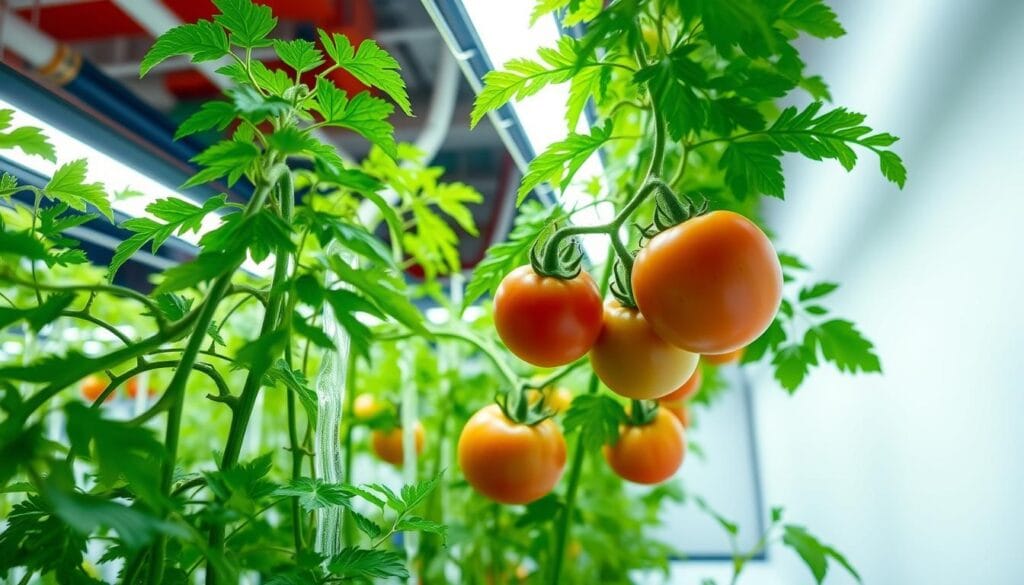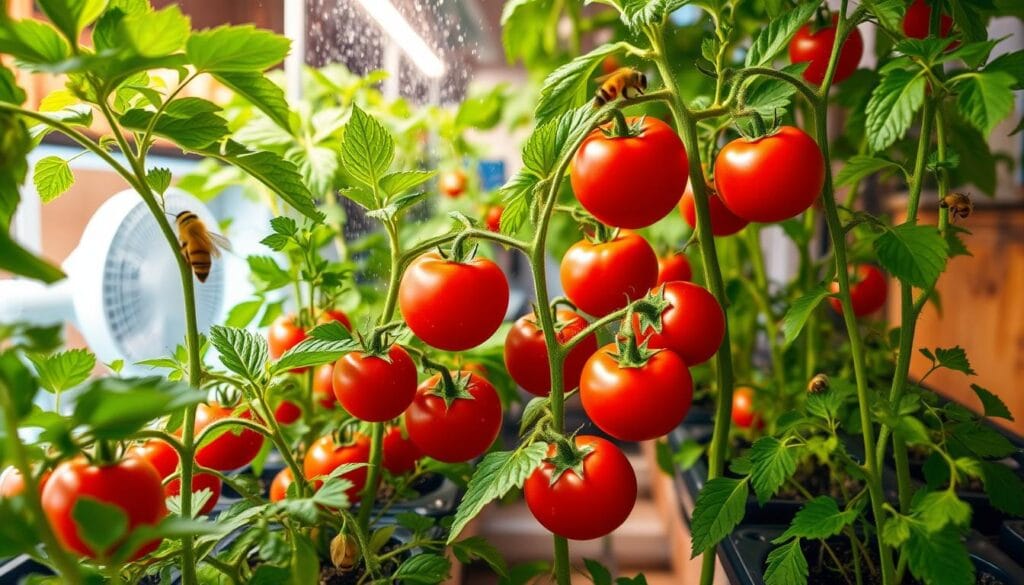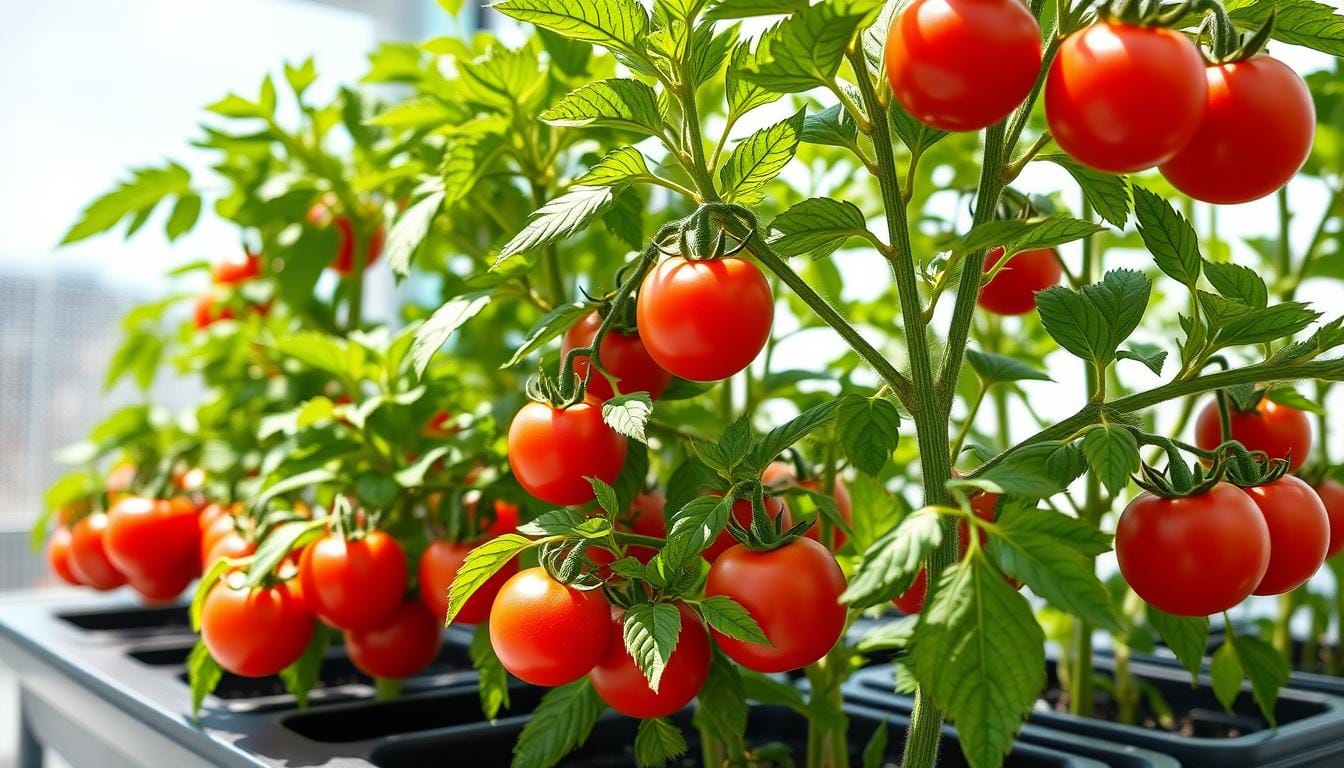Thinking about growing beefsteak tomatoes in small hydroponic systems? You’re probably excited about the controlled environment and space-saving benefits. Hydroponic tomato farming is a smart way to grow tomatoes indoors. With the right methods, you can get a big harvest.
Exploring hydroponic tomato farming opens up new possibilities. You’ll see how it boosts crop yields and cuts down water use. Whether you’re new to gardening or experienced, growing beefsteak tomatoes in small hydroponic systems is rewarding. It brings you closer to fresh, healthy food.
Key Takeaways
- Hydroponic tomato farming offers a controlled environment for growing beefsteak tomatoes
- Small hydroponic systems can maximize yields while minimizing space
- Growing beefsteak tomatoes in small hydroponic systems requires careful planning and attention to detail
- Hydroponic tomato farming can increase crop yields and reduce water consumption
- With the right techniques, you can enjoy a bountiful harvest of fresh, healthy beefsteak tomatoes
- Hydroponic systems provide an efficient way to cultivate tomatoes indoors
Understanding the Basics of Hydroponic Beefsteak Tomatoes
Many growers are now using small-scale hydroponics for indoor tomato gardening. This method is great for growing high-quality beefsteak tomatoes. It also helps save water and lets growers control the growing environment better.
One key benefit of hydroponic growing is the ability to control nutrients and pH levels. This ensures the tomatoes grow well and produce plenty of fruit. It’s perfect for growing beefsteak tomatoes.
Why Choose Hydroponic Growing
Hydroponic growing is perfect for starting an indoor tomato gardening project. It lets you grow tomatoes all year, no matter the weather. You can even grow them in small spaces, like balconies or large indoor gardens.
Benefits of Beefsteak Varieties
Beefsteak tomatoes are popular for hydroponic growing. They grow big and produce a lot of fruit. They’re also easy to grow and do well in many conditions. This makes them ideal for small-scale hydroponics.
Space Requirements Overview
Space can be a challenge in indoor tomato gardening with small-scale hydroponics. But, with the right planning and equipment, you can grow a lot in a small space.
Essential Equipment for Your Small Hydroponic Setup
Starting urban hydroponic agriculture needs some key equipment. For growing tomatoes hydroponically, you’ll need a grow tank, a pump, tubing, and a trellis. A good setup supports the plants’ weight and size.
A basic hydroponic system includes:
- Grow tank or reservoir
- Pump and tubing
- Trellis system for plant support
- Nutrient solution and pH management tools
In urban hydroponic agriculture, small and vertical systems save space. When growing tomatoes hydroponically, remember the plants’ needs for light, water, and nutrients. Knowing what equipment to use helps create a productive hydroponic system.
With the right tools and a good design, you can grow many plants, like tomatoes, using urban hydroponic agriculture. By understanding your plants’ needs, you can make a thriving hydroponic system.
| Equipment | Description |
|---|---|
| Grow tank or reservoir | Holds the nutrient solution and plant roots |
| Pump and tubing | Delivers nutrient solution to the plants |
| Trellis system | Supports plant growth and keeps plants upright |
Selecting the Right Beefsteak Tomato Varieties for Hydroponics
Choosing the right beefsteak tomato varieties is key for hydroponic success. You need varieties that do well in small setups and grow great fruit. Look at growth habits, disease resistance, and fruit size to make your choice.
Best Determinate Varieties
Determinate varieties are great for small hydroponic spaces because they grow compactly. Patio and Tiny Tim are popular choices. They’re perfect for snacking and salads.
Recommended Indeterminate Options
Indeterminate varieties also work well in hydroponics with the right support. Cherry Tomato and Beefsteak are favorites. They grow bigger and taste better than determinate varieties.
Disease-Resistant Cultivars
Disease-resistant varieties are a must in hydroponics. They fight off diseases like Verticillium and Fusarium. Better Boy and Early Girl are good choices.
Here are some top beefsteak tomato varieties for hydroponics:
- Patio
- Tiny Tim
- Cherry Tomato
- Beefsteak
- Better Boy
- Early Girl
Growing Beefsteak Tomatoes in Small Hydroponic Systems: Core Techniques
Growing beefsteak tomatoes in small hydroponic systems needs some key techniques. Hydroponic tomato farming is all about knowing what the plants need. This includes the right mix of nutrients, the perfect pH levels, and enough light. With these techniques, you can beat the challenges of small systems and grow great beefsteak tomatoes.
Here are the main things to think about:
- Nutrient solution composition: This is key for the plants to grow well and produce fruit.
- pH levels: Keeping the pH just right helps the plants take in nutrients and stay healthy.
- Lighting: Plants need enough light to grow and photosynthesize.
Mastering these techniques lets you grow beefsteak tomatoes in small hydroponic systems.
Remember, growing beefsteak tomatoes in small hydroponic systems needs a lot of attention and the right growing conditions. With time and effort, you can get lots of tomatoes and enjoy them all year.
| Factor | Optimal Range | Importance |
|---|---|---|
| Nutrient solution composition | Balanced mix of macronutrients and micronutrients | Critical for healthy plant growth |
| pH levels | 5.5-6.5 | Essential for nutrient uptake and plant health |
| Lighting | 18-24 hours of supplemental lighting | Crucial for photosynthesis and plant growth |
Secret #1: Optimizing Nutrient Solution Composition
Optimizing the nutrient solution is key for healthy plants in indoor tomato gardening and small-scale hydroponics. You must know the essential nutrients your plants need.
Essential Macronutrients
The main macronutrients are nitrogen, phosphorus, and potassium. These nutrients are vital for plant growth, from roots to fruit. In indoor tomato gardening, getting the right balance is essential for growth.
Critical Micronutrients
Iron and zinc are also critical for plant growth. They help with photosynthesis and plant health. In small-scale hydroponics, adding these micronutrients to the solution is important to avoid deficiencies.
pH Balance Management
Managing pH balance is vital in indoor tomato gardening and small-scale hydroponics. The ideal pH range for most plants falls between 5.5 and 6.5. Regularly check the pH and adjust the solution to ensure nutrients are available.
By optimizing the nutrient solution and managing pH, you create a perfect environment for your plants. This is critical in indoor tomato gardening and small-scale hydroponics, where control over growing conditions is essential for success.
Secret #2: Mastering Light Requirements
When growing tomatoes hydroponically, it’s key to give the right light. LED grow lights are great for this. They provide the controlled light tomatoes need to grow well.
To get the best light for your tomatoes, think about these points:
- Light intensity: Tomatoes need a lot of light, more so when they’re producing fruit.
- Light spectrum: LED lights can be set to give tomatoes the right mix of blue, red, and green light.
- Photoperiod: Tomatoes need at least 18 hours of light each day to grow well.
Getting the light right can really boost your tomato yields and quality. With the correct lighting, even small hydroponic setups can grow healthy tomatoes.

Secret #3: Temperature and Humidity Control Strategies
In urban hydroponic agriculture, managing temperature and humidity is key for plant growth. Small hydroponic setups face challenges in controlling these factors. But, it’s vital for healthy plants. To create the best environment for beefsteak tomatoes, keep the temperature between 65°F and 70°F. Also, maintain humidity levels at 50-60%.
To achieve this, consider the following tips:
- Keep the temperature steady both day and night
- Use humidifiers or dehumidifiers to control humidity levels
- Ensure good air circulation to prevent disease and promote healthy growth
In small hydroponic setups, air circulation is critical. It helps prevent disease and promotes healthy growth. By controlling temperature and humidity, you can create an optimal environment for your plants, even in urban hydroponic agriculture.
Here is a summary of ideal conditions for beefsteak tomatoes in small hydroponic setups:
| Factor | Ideal Range |
|---|---|
| Temperature | 65°F – 70°F |
| Humidity | 50-60% |
| Air Circulation | Good air movement |
Secret #4: Pruning and Training Methods
When cultivating beefsteak tomatoes in a hydroponic system, pruning and training are key. They help your plants grow well and produce more fruit. In indoor tomato gardening, where space is tight, these steps are even more important.
To prune your tomatoes, start by cutting off weak or spindly parts. This helps the plant grow strong and healthy. Also, remove lower leaves to stop disease and improve air flow. Use trellises or cages to help the plants grow up. This saves space and boosts your harvest.
- Removing suckers to promote a strong, single stem
- Training the plant to grow upwards using twine or clips
- Providing support for the fruit as it grows to prevent breakage
By using these techniques, you can make your indoor tomato gardening setup better. This way, you’ll get more and healthier cultivating beefsteak tomatoes.
Secret #5: Pollination Techniques for Indoor Growing
Growing beefsteak tomatoes indoors can be tricky because of missing pollinators. You can use manual pollination, mechanical tools, or adjust the environment for better pollination. This is key for hydroponic tomato farming, as it boosts fruit set and yield.
Temperature and humidity are vital for pollination in small hydroponic setups. Keep the temperature between 65-70°F (18-21°C) and humidity at 50-60%. This helps pollination work well.
Manual Pollination Steps
- Use a small, clean brush to gently transfer pollen from the anther to the stigma of the flower.
- Tap the anther gently to release pollen onto the brush.
- Transfer the pollen to the stigma, making sure to cover the entire surface.
Learning these pollination methods ensures your tomatoes get pollinated right. This leads to more and better tomatoes in your hydroponic farm. Keep an eye on temperature and humidity to help pollination.

Environmental Factors for Successful Pollination
Light and air circulation are also important for pollination. Make sure your hydroponic system has enough light and air. This helps plants grow well and pollinate successfully.
Troubleshooting Common Issues
In small-scale hydroponics and urban hydroponic agriculture, it’s key to spot and fix problems fast. This helps avoid big losses. You can solve common issues by keeping your system clean, picking disease-resistant plants, and making sure air flows well.
Disease Prevention
Stopping diseases is vital in small-scale hydroponics. Keep your system clean, choose disease-resistant plants, and ensure air circulates well. Common hydroponic diseases include root rot, leaf spot, and powdery mildew.
Nutrient Deficiencies
Fixing nutrient deficiencies means tweaking the nutrient solution. Common issues are nitrogen, phosphorus, and potassium shortages. Look for yellow leaves, slow growth, and poor fruit to spot these problems.
Growth Problems
Growth issues usually stem from things like light, temperature, and humidity. Fix these by tweaking your environment. For instance, boost light, adjust temperature, or up the humidity to help your plants grow well.
Knowing how to tackle common problems in small-scale hydroponics and urban hydroponic agriculture helps keep your system thriving. This way, you can grow healthy, productive plants.
| Common Problem | Solution |
|---|---|
| Disease | Maintain a clean system, use disease-resistant varieties, and ensure good air circulation |
| Nutrient Deficiency | Adjust the nutrient solution composition |
| Growth Problem | Adjust the environmental conditions to meet the needs of your plants |
Harvesting and Yield Maximization Tips
Growing tomatoes hydroponically means keeping a close eye on the fruit for ripeness. To get the most out of your harvest, try pruning, supporting the plants, and ensuring the best growing conditions. These steps will help you enjoy a rich harvest from your hydroponic setup.
Here are some tips for harvesting and boosting yields in hydroponic tomato production:
- Regularly inspect the plants for ripe fruit
- Use a trellis or other support system to keep the plants upright and promote better fruiting
- Ensure ideal growth conditions by managing temperature, humidity, and light levels effectively
- Prune the plants regularly to promote healthy growth and maximize yields
By following these tips and using the right techniques, you can successfully grow tomatoes hydroponically. Enjoy a high-yielding crop. Always keep an eye on your plants and adjust as needed for the best results in your hydroponic tomato production.
To further maximize yields, consider the following table outlining the benefits of different harvesting techniques:
| Harvesting Technique | Benefits |
|---|---|
| Regular harvesting | Promotes continuous fruiting, increases yields |
| Pruning and training | Improves plant structure, increases fruit quality |
| Optimal growing conditions | Supports healthy plant growth, maximizes yields |
Conclusion
Starting your journey to grow beefsteak tomatoes in small hydroponic systems opens up endless possibilities. This guide will help you grow juicy, flavorful tomatoes at home. It’s perfect for both experienced gardeners and newcomers to indoor tomato gardening.
By focusing on the right nutrients, lighting, and pruning, you’ll see the best in beefsteak tomatoes. You can overcome space limits and create a thriving hydroponic system. This system will give you a rich harvest every season.
Keep improving your skills and trying new things. Hydroponics lets you control your food, reduce waste, and enjoy fresh tomatoes. Stay patient, flexible, and curious. Let your love for growing beefsteak tomatoes in small hydroponic systems guide you to success.

